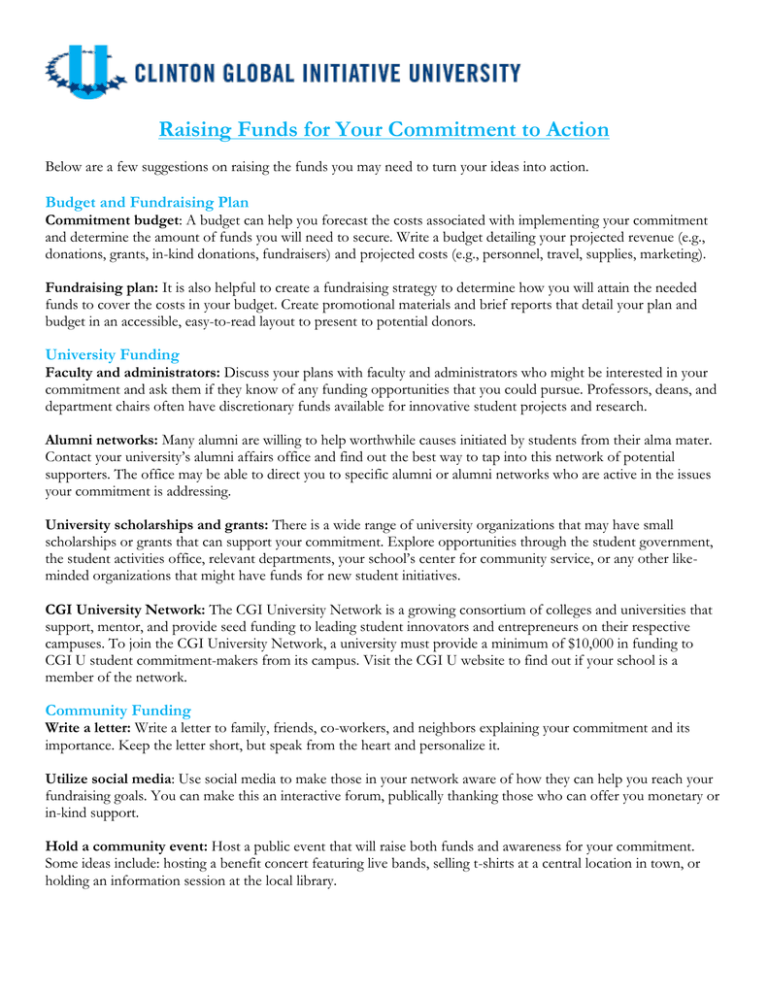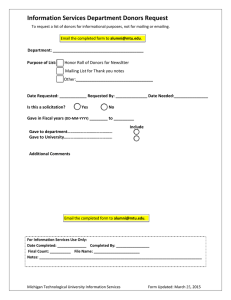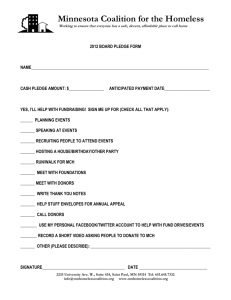Raising Funds for Your Commitment to Action Budget and Fundraising Plan
advertisement

Raising Funds for Your Commitment to Action Below are a few suggestions on raising the funds you may need to turn your ideas into action. Budget and Fundraising Plan Commitment budget: A budget can help you forecast the costs associated with implementing your commitment and determine the amount of funds you will need to secure. Write a budget detailing your projected revenue (e.g., donations, grants, in-kind donations, fundraisers) and projected costs (e.g., personnel, travel, supplies, marketing). Fundraising plan: It is also helpful to create a fundraising strategy to determine how you will attain the needed funds to cover the costs in your budget. Create promotional materials and brief reports that detail your plan and budget in an accessible, easy-to-read layout to present to potential donors. University Funding Faculty and administrators: Discuss your plans with faculty and administrators who might be interested in your commitment and ask them if they know of any funding opportunities that you could pursue. Professors, deans, and department chairs often have discretionary funds available for innovative student projects and research. Alumni networks: Many alumni are willing to help worthwhile causes initiated by students from their alma mater. Contact your university’s alumni affairs office and find out the best way to tap into this network of potential supporters. The office may be able to direct you to specific alumni or alumni networks who are active in the issues your commitment is addressing. University scholarships and grants: There is a wide range of university organizations that may have small scholarships or grants that can support your commitment. Explore opportunities through the student government, the student activities office, relevant departments, your school’s center for community service, or any other likeminded organizations that might have funds for new student initiatives. CGI University Network: The CGI University Network is a growing consortium of colleges and universities that support, mentor, and provide seed funding to leading student innovators and entrepreneurs on their respective campuses. To join the CGI University Network, a university must provide a minimum of $10,000 in funding to CGI U student commitment-makers from its campus. Visit the CGI U website to find out if your school is a member of the network. Community Funding Write a letter: Write a letter to family, friends, co-workers, and neighbors explaining your commitment and its importance. Keep the letter short, but speak from the heart and personalize it. Utilize social media: Use social media to make those in your network aware of how they can help you reach your fundraising goals. You can make this an interactive forum, publically thanking those who can offer you monetary or in-kind support. Hold a community event: Host a public event that will raise both funds and awareness for your commitment. Some ideas include: hosting a benefit concert featuring live bands, selling t-shirts at a central location in town, or holding an information session at the local library. Apply for grants: Research various foundations and other grant opportunities that could potentially provide funding for your commitment. Many large corporations will match their employees’ contributions one-to-one. Check with your existing donors to see if their companies have matching programs. Create a website: Even the most basic website or blog can become an invaluable fundraising tool. A secure donation form can enable users to donate to your commitment in a matter of seconds. A web presence with information and photos about your commitment can also generate increased buzz and interest in your work. Contact the local media: Contact your local newspaper and college media sources (e.g., newspaper, website, alumni magazine, school blog) and ask them to write an article about your commitment. Work with local community groups: Reach out to local community groups that address similar issues as your commitment. Attend a meeting or speak on the phone with a key representative of the organization to let them know about your commitment. Local non-profits could be potential partners or might know of potential donors. Developing and Maintaining Donor Relations Provide Multiple Ways to Donate Monetary: make it easy for donors to donate. Set up an online account to make it easy for potential donors to fund your project. Also, provide a mailing address for those preferring to mail donations to you instead. Sponsorship: start a campaign for donors to sponsor a product or service for the beneficiary (e.g., pay a teacher’s salary, fund training for a local co-op). Pro bono: in lieu of donations, ask for pro bono services such as legal services, marketing advice, or consulting. Events: host events or ask donors to host events (e.g., birthday parties or other types of parties) and ask attendees to donate to your project rather than bringing gifts. Collect Data Collect all pertinent data about donors (e.g., names, addresses, donation amounts, dates of donations). Save the data in a user-friendly database where you can easily create illustrative charts and tables of donor data. Show Gratitude Write thank you notes to donors – the more personalized the note, the better. Plan donor appreciation events or provide donors with small gifts of thanks. Find ways to publically recognize donors via social media or on your website. Keep in touch with your donors and continue to engage them in your work. Newsletter Create a monthly e-newsletter that includes progress on your project. Professionalize your letter by having a clear format and including a logo. Use multimedia like videos and photos to enhance your newsletter. Include an opt-out option in the newsletter for donors who no longer wish to receive updates. Include links to your project’s website and social media sites. Seek Advice Ask for suggestions on how to develop your work and improve donor relations. Encourage your donors to recommend potential partners or relevant resources that can enhance your project. Utilize Your Donor Network Encourage donors to share your project with their network. If a donor belongs to a society or members-only organization (e.g., Rotary or Lions Clubs), ask if you can make a presentation at a meeting.





